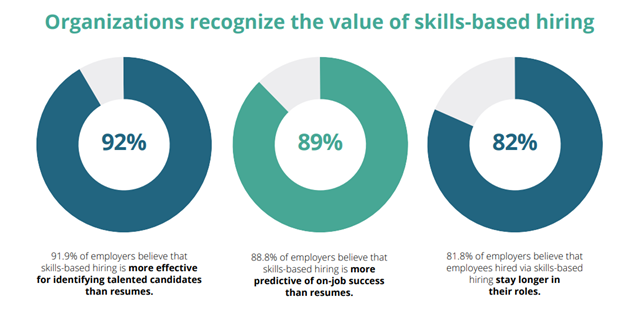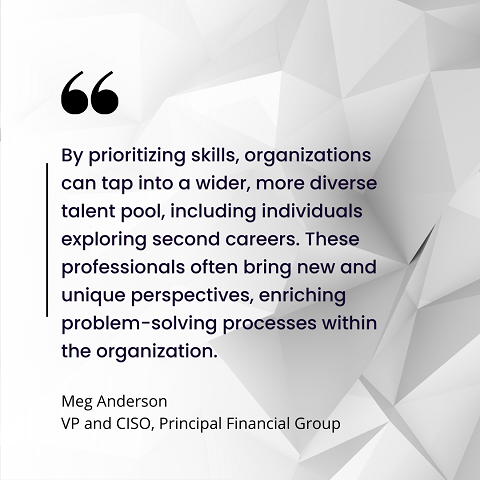Skills-Based Hiring: A Pathway to Unlocking Diverse Talent in Today's IT WorkforceSkills-Based Hiring: A Pathway to Unlocking Diverse Talent in Today's IT Workforce
Skills-based hiring offers a more comprehensive view of workforce capabilities and addresses the IT talent shortage while fostering innovation and agility.
April 30, 2024

Prioritizing a skills-based hiring approach can help organizations tap into a pool of talent that possesses the expertise needed to address current challenges and anticipate future ones.
Recent research from TestGorilla indicated a shift toward skills-based hiring over traditional resumes, with 70% of more than 3,000 global respondents finding it more effective.
Nearly three-quarters (73%) of companies surveyed said they are already implementing this approach, while 86% of job seekers said they believe it enhances their chances of landing their ideal job.
Skills-based hiring creates a more complete view of what the workforce can accomplish and how they can adapt to new roles and responsibilities.

In the event of a labor shortage, this can lead to more accurate work assignments and project management, and allow organizations to better understand the value of its employee base.
Moreover, individuals who actively engage with free training and resources not only demonstrate resourcefulness but also a commitment to lifelong learning and adaptation — critical attributes for a workforce poised to thrive in a rapidly changing environment.
Fostering a Culture of Innovation, Agility
"This approach helps ensure that organizations stay at the forefront of technological advancements," said Meg Anderson, vice president and chief information security officer of Principal Financial Group.
It also fosters a culture of innovation and agility, ultimately building a workforce that is not just adaptable but also primed for sustained success in the face of evolving industry landscapes.

Anderson said a skills-based hiring strategy is instrumental in navigating the challenges posed by today's workforce landscape.
"By prioritizing skills, organizations can tap into a wider, more diverse talent pool, including individuals exploring second careers," she explained. "These professionals often bring new and unique perspectives, enriching problem-solving processes within the organization."
From her perspective, embracing this approach helps organizations fill critical roles more efficiently and effectively, leveraging the varied expertise and perspectives of a diverse talent pool to address talent scarcity and foster innovation.
"It shouldn't be surprising to anyone that the global educational system cannot evolve as quickly as the current state of the tech sector," said Jason Wodicka, principal engineering advocate at Karat. "But pedigree-based hiring relies on that system as a primary signal."
Because of that, it ends up being optimized for what was needed in the past, at the time when the curriculum was written or the past job held.
"By adopting a skills-based approach to hiring, you can focus and hire for your workforce needs of today," Wodicka said. "This approach ensures your process remains coupled to the real needs of your organization."
Setting Talent Pipeline Priorities
Ashutosh Garg, co-CEO of Eightfold AI, said organizations can effectively transition from a traditional degree-focused hiring approach to a skills-based hiring strategy by setting priorities at the start of the talent pipeline.
"It is possible to blind your system to any detail you'd like — name, education, age, gender, race — these are all ways that unconscious bias can enter the equation," he said. "Beginning your search by breaking down the skills necessary for a role to succeed, and examining options from there, is the starting point."
Another key element for success is workforce planning — understand where the organization wants to go in six months, one year, or even five years.
"Having a better understanding of the scale and direction of your company's evolution will give you a roadmap of what skills will be necessary to succeed there," Garg said.

As a first step, hiring managers should conduct a comprehensive review of the job descriptions for their open roles to ensure the language does not inadvertently alienate employees without traditional degree requirements, according to Josh Brenner, CEO of Hired.
"Instead of placing undue emphasis on specific educational prerequisites such as degrees, the focus should shift toward outlining the essential soft and hard skills necessary for fulfilling the responsibilities of the role," he said.
Descriptions should be updated to include specific examples of online certifications or specific projects and experiences the organization deems acceptable.
"Secondly, companies may need to explore unconventional recruiting methods to seek out qualified candidates with nontraditional backgrounds," Brenner explained.
Rather than relying solely on conventional job boards or organizing job fairs at universities, organizations should consider launching virtual events, such as hackathons and coding challenges, to attract candidates based on their skill sets.
"Coding challenge events combine the opportunity to strengthen employer brands in the tech community, tap into new markets, and assess tech skills in one go," he said.
Companies should also be open to resumes from individuals who have successfully completed coding bootcamps or apprenticeship programs.
Brenner said it's important to note that some graduates choose to pivot into tech roles after years of experience in specific industries, such as healthcare or financial services, and bring a wealth of knowledge beyond engineering to tech teams.
Embracing Nontraditional Backgrounds
In the emerging technology sector specifically, hiring managers should consider the unique strengths and qualities that these nontraditional candidates possess, including innovative thinking, curiosity flexibility, and eagerness to learn.
"We saw a trend of employers harnessing innovative talent amid the emergence of blockchain and Web3 roles," Brenner explained. "As a newer technology, it was unlikely recruiters would find candidates with several years of experience in these roles, so they leaned into candidates with many of the traits listed above."
Survey data from Hired's 2023 State of Software Engineers report found that the top two reasons engineers pursued their career were the appeal of new challenges and continuous learning (69%) and building products/solutions and problem-solving (66%).
"Employers will have a significant hiring advantage if they provide these opportunities," Brenner said.
By including candidates with nontraditional education backgrounds, including those who completed certifications or bootcamps, companies are opening themselves up to an entire workforce sector previously underutilized.
"Companies can then use this wealth of previously untapped talent to fill empty critical roles more quickly and effectively address talent scarcity for specific skills their teams lack," he said.
By incorporating skills assessments, AI-powered tools, and competency- or skills-based interview techniques, companies can create a more transparent and equitable hiring process for candidates.
"AI can empower hiring teams to significantly expedite the time it takes to identify qualified candidates, craft personalized outreach emails, and schedule interviews, allowing them to channel their efforts into more significant aspects of their roles, such as enhancing the overall candidate experience," Brenner said.
Establishing Standards for a Skills-Based Approach
Also key is establishing standards for how you're evaluating candidates, according to Wodicka, noting that the goal is a process where every candidate gets the same opportunity to show how they would succeed at the job, and the skills they show are the primary factor in who gets hired.
"By evaluating candidates based on what they can actually do, instead of leaning back on proxies like where they've previously worked or studied, you open the playing field for the best possible talent," they said.
Given the "enormous number" of applicants seeking work in the broader tech sector, Wodicka said it's hard to take claims of a technical skill shortage too seriously.
"But it's true that the companies reporting this are experiencing a shortage," they said. "The key is that the real shortage is not of capable workers, but of people who can show the right signifiers to proceed in an outdated hiring process."
From Wodicka's perspective, companies can unlock access to a wider and more diverse talent pool by moving to a skill-based strategy.
"This doesn't require settling for people who can't do the job, either," they added. "By its very structure, a skills-based process is designed to ensure that the ability to do the job is at the center of the process."
About the Author
You May Also Like








.jpg?width=700&auto=webp&quality=80&disable=upscale)
